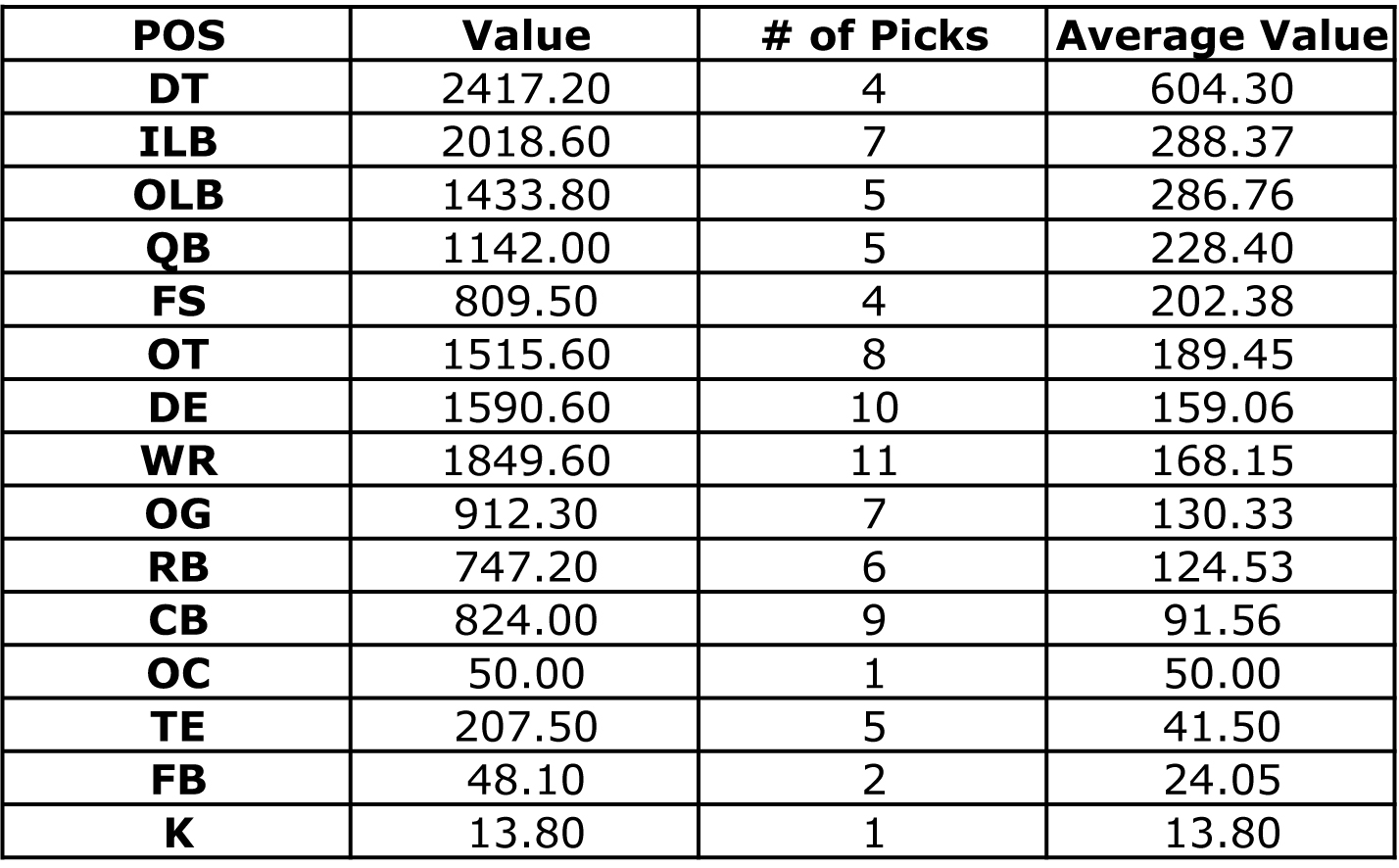
 One thing that many fans have noticed over the years is that Ted Thompson does not like to draft interior offensive linemen, instead preferring to draft tackles and converting them into the interior once they reach the NFL. This concept seems to indicate that in the NFL there is a premium placed on some positions while not others; for instance quarterback is naturally considered the premium position of premium positions, traditionally followed by some combination of pass rushers and wide receivers. However each team is different, for instance while the Packers do not put much stock into interior offensive linemen, the Packers have shown a love for fullback/H-backs which most team’s don’t even keep a roster spot for anymore. So the question is, what are the positions that Ted Thompson favors or is willing to spend precious draft resources for and does Thompson’s weight of draft investment differ significantly with other teams?
One thing that many fans have noticed over the years is that Ted Thompson does not like to draft interior offensive linemen, instead preferring to draft tackles and converting them into the interior once they reach the NFL. This concept seems to indicate that in the NFL there is a premium placed on some positions while not others; for instance quarterback is naturally considered the premium position of premium positions, traditionally followed by some combination of pass rushers and wide receivers. However each team is different, for instance while the Packers do not put much stock into interior offensive linemen, the Packers have shown a love for fullback/H-backs which most team’s don’t even keep a roster spot for anymore. So the question is, what are the positions that Ted Thompson favors or is willing to spend precious draft resources for and does Thompson’s weight of draft investment differ significantly with other teams?
To measure this, I took every draft selection made by Ted Thompson during his tenure with the Green Bay Packers, assigned each player to the position they played for the majority of the time and then assigned them a draft value based on which pick they were selected using the “Jimmy Johnson’s Dallas Cowboys” draft trade chart as a metric. Some caveats of course is that the Packers did switch from a 4-3 bump and run style defense to a blitzburgh 3-4 defense in 2009, which obviously changes what type of players the Packers select and where players ultimately end up playing (for instance AJ Hawk was supposed to play OLB in the 4-3 and moved to ILB in the 3-4). Also the trade chart has come under scrutiny as of late (myself included); it’s unlikely to be all that accurate or precise in determining trade value and it’s likely that every team has their own modified chart with different values for each draft pick. However, since all of this information is kept tightly in war rooms (unless you happen to be ironically the Dallas Cowboys), the original trade chart will be used knowing that the rough values are likely to be similar.
First off, the most striking thing is that Ted Thompson isn’t afraid to pick a defensive tackle high in the draft; looking at the draft from a value perspective, Thompson made heavy investments in the defensive tackle position with the selection of Justin Harrell with the 16th overall selection and BJ Raji with the 9th overall selection. Outside of these two premium picks, Thompson hasn’t really drafted all that many defensive tackles, with only Johnny Jolly and Mike Daniels (who operates like a 4-3 DT in 3-4 nickel packages) as the two other draft selections.
The second most striking thing is that Thompson likes to draft a lot of linebackers, with both averaging a draft selection value of around 290 (which near the bottom of the 2nd round in trade chart value) per player. Obviously AJ Hawk’s selection skews the linebacker values heavily as the only top 10 pick ever selected by Thompson but overall, Thompson likes to draft linebackers early and often, with early selections including Clay Matthews, AJ Hawk and Nick Perry and a often including Terrell Manning, Sam Barrington, Desmond Bishop, Nate Palmer and Ricky Elmore. Maybe it’s because the Packers like the body type and skill set on special teams or because Ted Thompson is a former linebacker, but the Packers have put a lot of investment into their linebacking core.
On the flip side, the Packer’s do not put as much emphasis on wide receivers and cornerbacks; two positions often considered premium positions by many in the NFL. It’s likely that Thompson hasn’t been forced to select a wide receiver early since any wide receiver will perform better around Brett Favre and Aaron Rodgers (just ask Greg Jennings), but the Packers have curiously been poor drafters of cornerbacks. Almost all the key players at cornerback have not been drafted by the Packers; Al Harris came from a trade with the Philadelphia Eagles, Charles Woodson was a free agent who played with the Raiders, Tramon Williams was an undrafted free agent who signed on after being cut by the Houston Texans and Sam Shields was another undrafted free agent who converted from college wide receiver. Arguably, Thompson proposed lack of success in drafting cornerbacks could also be linked to the fact that he selects a lot of cornerbacks in the class but always in the later rounds (save for maybe the exception of Pat Lee, who was a 2nd round pick).
Interestingly, while cornerback and safety are often lumped together due to a common skill set and a tradition of conversion projects; the Packers spend a lot more on per safety (who I’ve labeled all FS since FS and SS are interchangeable for the Packers at this point). The Packers have spent relative the same draft value on both safeties and cornerbacks but with half the number of total selections meaning that they tend to draft safeties considerably higher than their cornerback counterparts.
Finally quarterback is an interesting position because while it is high on the list of draft investment value it’s not the highest, falling behind both defensive tackles and linebackers. Obviously some of this has to do with the fact that Thompson hit the jackpot in his very first draft with Aaron Rodgers and hasn’t continually need to invest more resources into quarterback but it’s also likely that long term quarterback isn’t all that valuable of a position, with the reason that highly selected quarterbacks likely have a secure position for way longer than any other position can expect (see Blame Gabbert, Christian Ponder, or any other 1st round QB bust). Counter to that is the draft is the only place where teams can find a star quarterback as they never hit free agency, but again this is likely offset by the fact that teams will draft a quarterback highly in one year and then not again for several years as they determine if they’ve gotten the real deal (see St. Louis Rams and Sam Bradford). Take this in comparison to wide receiver, where a team could theoretically draft a wide receiver high year after year (or stupidly if you are Matt Millen and the Lions).
Overall, it would be interesting to see if any other trends emerge from this kind of data; do more successful teams put more investment into certain positions and does league wide data actually corroborate with previous held notions that quarterbacks, pass rushers and wide receivers are the premium positions that teams must invest heavily in? I would argue that the distinction between premium and non-premium positions is a lot more variable than most fans believe; for instance teams can get away with lower quality wide receivers if they have a premium quarterback and some schemes and philosophies demand more premium players than other, for instance there are always more 4-3 pass rushing defensive ends and 3-4 pass rushing outside linebackers due to the vast majority of college teams playing 4-3 defenses. In reality, teams like the Packers draft players for a variety of reasons including fit, mentality, personality, economics, scheme and philosophy and at the end of the day, it was a good selection if they can play.
——————
Thomas Hobbes is a staff writer for Jersey Al’s AllGreenBayPackers.com.
——————


Stupid and Matt Millen always work well in the same sentence…
The more I think about it, the more I feel like he actually had a pretty rational idea. Only problem was no idea how to implement it and was more famous for bickering and ineptitude than actually running a football team.
Interesting statistical analysis. I have a very different interpretation of what the numbers show. They are an excellent indicator of how successful you have been at acquiring quality players at each position. We all know that TT has been very successful drafting WRs. Similarly, he has been quite successful acquiring CBs but not through the draft. On the flip side, he has been spectacularly unsuccessful at acquiring quality DTs, LB and S through the draft and/or free agency. When unsuccessful, the demand remains high, so you are forced to draft over and over at the same position. I’m a bit surprised OT & OG aren’t even higher than they are given the great number of picks as well as at least a couple of top picks, though at the end of R1.
Great point Archie.
Although I think finding Collins and Bishop for the value TT did makes the “spectacularly unsuccessful” S/ILB thing a bit of a stretch.
Great point Archie.
Although I think finding Collins and Bishop for the value TT did makes the “spectacularly unsuccessful” S/ILB thing a bit of a stretch.
I should mention I’m not bring this further out to correlate draft position with production (which might be an interesting article in the future). At this point I’m simply looking at where the Packers have spent their draft resources. Desmond Bishop and Ricky Elmore were roughly the same investment, which has nothing to do with their on-field performance.
One big thing to consider is that draft value chart is roughly longitudinal, meaning top 10 picks are significantly more of an investment than even 10-20 picks. I had the same thought as you but I wasn’t sure how to correlate the two, I would argue that nick collins was a very successful pick at safety.